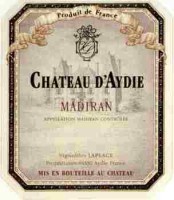 Chateau d’Aydie and the Laplace family are widely regarded as one of the foremost quality producers of Madiran wines is deep Southwest France. Frédéric Laplace was recognised as one of the pioneer winemakers to bottle Madiran wines and to sell them under his own name when the appellation was created in 1948 – when there was just 50 hectares of vineyard under production, compared to the 1650 hectares which now produce Madiran wines.
Chateau d’Aydie and the Laplace family are widely regarded as one of the foremost quality producers of Madiran wines is deep Southwest France. Frédéric Laplace was recognised as one of the pioneer winemakers to bottle Madiran wines and to sell them under his own name when the appellation was created in 1948 – when there was just 50 hectares of vineyard under production, compared to the 1650 hectares which now produce Madiran wines.
The whole venture is very much a family affair – the three grandsons and granddaughter of Frédéric run the estate between them – Francois in charge of the business side; Jean-Luc is in charge of wine-making; Bernard manages the vines; and Marie presides over the office, whilst their father Pierre is in semi-retirement but still very much involved.
In his book “The New France” Andrew Jefford says of Chateau d’Aydie “Everything is impeccably clean, minutely organised, deeply considered, exhaustively refined…. a range of model Madirans”  The New France: A Complete Guide to Contemporary French Wine (Mitchell Beazley Wine Guides)
The New France: A Complete Guide to Contemporary French Wine (Mitchell Beazley Wine Guides)
At Allez Vins! we imported 3 superb Madiran cuvées from Chateau d’Aydie and a couple of excellent Vins de Pays. The key difference between the Madirans is the percentage of the Tannat grape used.
MADIRAN is one of our favourite appellations – seriously undervalued and overlooked on so many ocassions. These are big, tannic red wines of considerable character and style – and in earlier decades they were rightly regarded with a little caution especially when young. However, in recent years a younger generation has revolutionised the wines of the region, such that the best of these wines seriously challenge overpriced top Bordeaux. Techniques of retaining the tannic structure, whilst making the wines more fruity and approachable have transformed these wines. We are proud to feature the wines of 2 top domaines with varying styles and including some which we consider to be amongst the very best wines we have stocked.
have transformed these wines. We are proud to feature the wines of 2 top domaines with varying styles and including some which we consider to be amongst the very best wines we have stocked.
The Madiran vineyard dates back to the first century BC. During the 11th century, the Benedictine monks founded the Abbey of Madiran and further developed the vines. Madiran was made an AOC (Appellation d’Origine Controllée or AC) in 1948 and was the first AOC to begin the process of receiving a quality control note after being analysed and tasted by the selection panel.
MADIRAN & PACHERENC DU VIC BILH
The area is known in the local dialect as Vic Bilh , a region which stretches out across three departments – the Gers, the Pyrénées-Atlantiques and the Hautes-Pyrénées. The silica clay soils are highly suited to the production of white Pacherenc varieties and the chalky clay soils are very suited to the red varieties producing Madiran. The area of vine extends over 1,600 hectares (of which 1,400 produce Madiran). Total production stands at around 75,000hl for Madiran and 8,000 hl for Pacherenc.
GRAPE VARIETIES Four varieties are used to produce Madiran : Tannat is the main grape (40-60%). A classic variety – it adds structure and an unusual, unique taste. Cabernet Franc (Bouchy) and Cabernet Sauvignon add suppleness, bouquet and finesse. Fer Servadou (or Pinenc) adds a fruity element to the mix of aromas. High in tannin, Madiran is a well-structured full-bodied red wine. A production decree insists that it be aged for one year before being released for sale. After 2 – 3 years in bottle, the tannins soften and it develops a bouquet of dark fruits, of roasted coffee beans and spices. It reaches its peak after 4 – 8 years but can be enjoyed while young.
The local white wine is quite rare and is called “Pacherenc de Vic Bihl. It is made from six varieties : Arrufiac, Petit and Gros Manseng, Courbu, Sauvignon and Sémillon.
Discover more from FrenchDuck.com
Subscribe to get the latest posts sent to your email.
Cynthia Hurley at La Route du Vin writes:
Chateau d’Aydie is in a utopian spot on a hilltop overlooking a panorama of vineyards sheltered by the curves of the River Ardour. I knew I was in for some good bottle tilting here, but I didn’t expect Marie to stage a banquet of white asparagus, slabs of foie gras the size of my TV remote control and duck breasts which must have come from some avian super race.
The large triangle of tarte tatin which appeared at the end will be an indomitable task to finish off, I said to myself, but yet, moments later, I had managed to go the distance and have a crumbless plate. And all washed down with some of the most succulent juice I had encountered in awhile. Lunch was over at 5pm.
Chateau d’Aydie is a family affair. Francois is responsible for the commercial and marketing side. Marie handles all of the administration and a few other things which we’ve already covered. Bernard is master of the vines and all that goes on outside and Jean-Luc is the wine maker.
Pierre is the pere and still advises. He is ruggedly handsome and I was enchanted to see a black beret atop his pate at a time when that lovely circlet of wool has lost hold in sartorial circles of France. Some things are slow to change in Madiran, but not the wine.